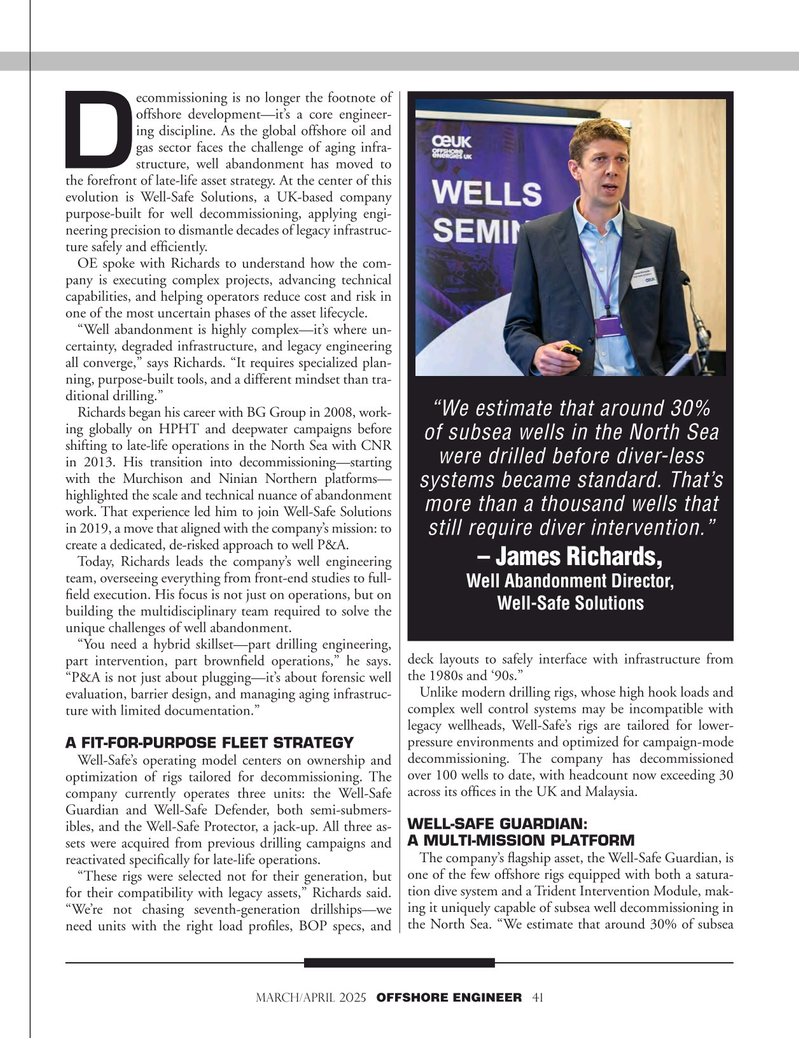
Page 41: of Offshore Engineer Magazine (Mar/Apr 2025)
Read this page in Pdf, Flash or Html5 edition of Mar/Apr 2025 Offshore Engineer Magazine
ecommissioning is no longer the footnote of offshore development—it’s a core engineer- ing discipline. As the global offshore oil and gas sector faces the challenge of aging infra- structure, well abandonment has moved to
D the forefront of late-life asset strategy. At the center of this evolution is Well-Safe Solutions, a UK-based company purpose-built for well decommissioning, applying engi- neering precision to dismantle decades of legacy infrastruc- ture safely and effciently.
OE spoke with Richards to understand how the com- pany is executing complex projects, advancing technical capabilities, and helping operators reduce cost and risk in one of the most uncertain phases of the asset lifecycle.
“Well abandonment is highly complex—it’s where un- certainty, degraded infrastructure, and legacy engineering all converge,” says Richards. “It requires specialized plan- ning, purpose-built tools, and a different mindset than tra- ditional drilling.” “We estimate that around 30%
Richards began his career with BG Group in 2008, work- ing globally on HPHT and deepwater campaigns before of subsea wells in the North Sea shifting to late-life operations in the North Sea with CNR were drilled before diver-less in 2013. His transition into decommissioning—starting with the Murchison and Ninian Northern platforms— systems became standard. That’s highlighted the scale and technical nuance of abandonment more than a thousand wells that work. That experience led him to join Well-Safe Solutions in 2019, a move that aligned with the company’s mission: to still require diver intervention.” create a dedicated, de-risked approach to well P&A.
– James Richards,
Today, Richards leads the company’s well engineering team, overseeing everything from front-end studies to full-
Well Abandonment Director, feld execution. His focus is not just on operations, but on
Well-Safe Solutions building the multidisciplinary team required to solve the unique challenges of well abandonment.
“You need a hybrid skillset—part drilling engineering, part intervention, part brownfeld operations,” he says. deck layouts to safely interface with infrastructure from “P&A is not just about plugging—it’s about forensic well the 1980s and ‘90s.”
Unlike modern drilling rigs, whose high hook loads and evaluation, barrier design, and managing aging infrastruc- complex well control systems may be incompatible with ture with limited documentation.” legacy wellheads, Well-Safe’s rigs are tailored for lower- pressure environments and optimized for campaign-mode
A FIT-FOR-PURPOSE FLEET STRATEGY
Well-Safe’s operating model centers on ownership and decommissioning. The company has decommissioned optimization of rigs tailored for decommissioning. The over 100 wells to date, with headcount now exceeding 30 company currently operates three units: the Well-Safe across its offces in the UK and Malaysia.
Guardian and Well-Safe Defender, both semi-submers-
WELL-SAFE GUARDIAN: ibles, and the Well-Safe Protector, a jack-up. All three as- sets were acquired from previous drilling campaigns and A MULTI-MISSION PLATFORM
The company’s fagship asset, the Well-Safe Guardian, is reactivated specifcally for late-life operations.
“These rigs were selected not for their generation, but one of the few offshore rigs equipped with both a satura- for their compatibility with legacy assets,” Richards said. tion dive system and a Trident Intervention Module, mak- “We’re not chasing seventh-generation drillships—we ing it uniquely capable of subsea well decommissioning in need units with the right load profles, BOP specs, and the North Sea. “We estimate that around 30% of subsea march/april 2025 OFFSHORE ENGINEER 41

 40
40

 42
42